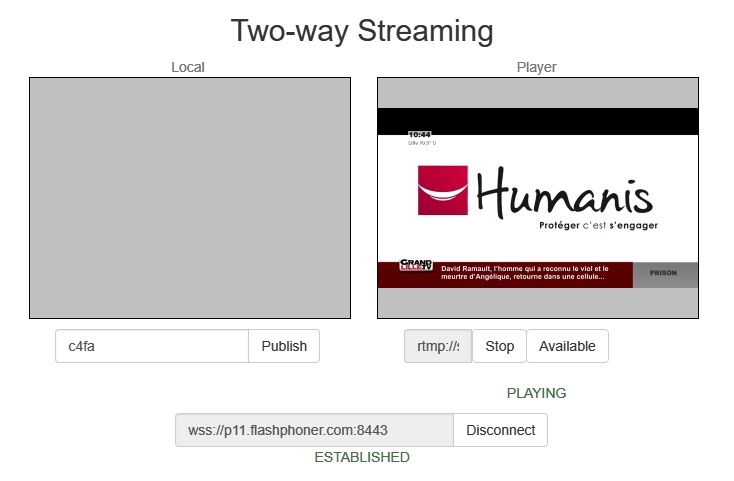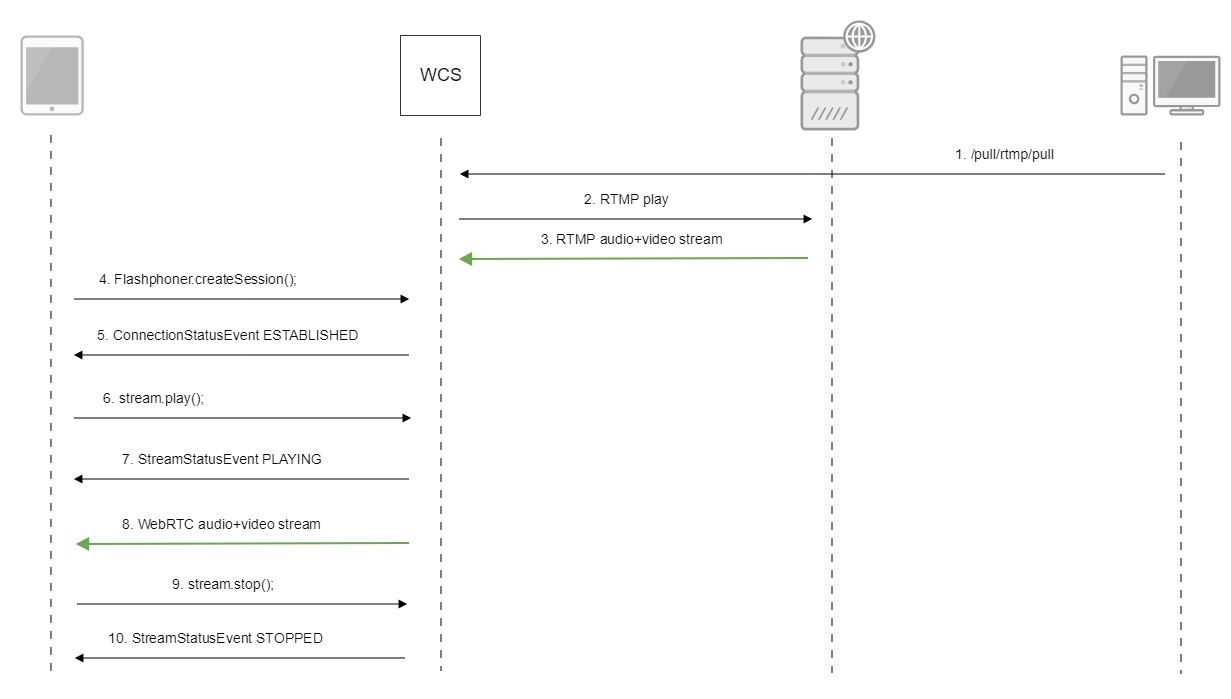Overview
WCS can capture an RTMP video stream published by another server, by request. The captured stream can be broadcast to any of supported platforms using any of supported technologies. Managing of RTMP stream capturing is performed using REST API.
Operation flowchart
- The /pull/rtmp/pull REST query is sent to the WCS server
- The WCS server requests the RTMP stream from the specified server
- The RTMP stream is broadcast to the WCS server
- The browser requests playing the captured stream via WebSocket
- The browser receives the stream via WebRTC
REST queries
A REST-query must be an HTTP/HTTPS POST request as follows:
- - HTTP: http://test.flashphoner.com:8081/rest-api/pull/rtmp/pull
- - HTTPS: https://test.flashphoner.com:8444/rest-api/pull/rtmp/pull
Where:
- - test.flashphoner.com - is the address of the WCS server
- - 8081 - is the standard REST / HTTP port of the WCS server
- - 8444 - is the standard HTTPS port
- - rest-api - is the required part of the URL
- - /pull/rtmp/pull - is the REST method used
REST-methods and response statuses
REST-method | Example of REST-query | Example of REST response | Response status | Description |
|---|---|---|---|---|
/pull/pull | {
"uri":"rtmp://myserver.com/live/myStream",
"localStreamName":"stream1",
"record": "false",
"hasAudio": true,
"hasVideo": true
}
| 409 - Conflict 500 - Internal error | Pull the RTMP stream at the specified URL | |
/pull/find_all | {
"localMediaSessionId": "5a072377-73c1-4caf-abd3"
"localStreamName": "stream1"
"uri": "rtmp://myserver.com/live/myStream",
"status": "PROCESSED_REMOTE",
"hasAudio": true,
"hasVideo": true,
"record": false
}
| 200 – streams are found 500 - Internal error | Find all pulled RTMP streams | |
/pull/terminate | {
"uri":"rtmp://myserver.com/live/myStream"
}
| 200 - stream terminated 500 - Internal error | Terminate the pulled RTMP stream |
Parameters
Parameter name | Description | Example |
|---|---|---|
uri | URL of the RTMP stream | rtmp://myserver.com/live/myStream |
| record | Is the pulled stream recording | true |
localMediaSessionId | Session identifier | 5a072377-73c1-4caf-abd3 |
localStreamName | Local name assigned to the captured stream. By this name the stream can be requested from the WCS server | stream1 |
status | Current stream status | PROCESSED_REMOTE |
| hasAudio | Stream has audio track | true |
| hasVideo | Stream has video track | true |
Pulled stream publishing with a given name
Since build 5.2.724 it is possible to set the name to publish stream on server using localStreamName query parameter. If the parameter is not set, the stream name will be set to uri , as done in previous builds.
RTMP stream repeatedly capturing with the same URI
/pull/rtmp/pull query returns 409 Conflict while trying to repeatedly capture RTMP stream with the same URI. If the stream is already published on the server, it is necessary to subscribe to it.
Audio only or video only stream publishing
Since build 5.2.1439 it is possible to set in REST query how to publish an RTMP stream captured on WCS. For example, to publish a video only stream, set
{
"uri":"rtmp://myserver.com/live/myStream",
"localStreamName":"stream1",
"hasAudio": false,
"hasVideo": true
}
Configuration
Codecs parameters definition
In the /usr/local/FlashphonerWebCallServer/conf directory you can find the SDP description file for the RTMP agent rtmp_agent.sdp :
v=0 o=- 1988962254 1988962254 IN IP4 0.0.0.0 c=IN IP4 0.0.0.0 t=0 0 a=sdplang:en m=video 0 RTP/AVP 95 a=rtpmap:95 H264/90000 a=fmtp:95 profile-level-id=42e01f;packetization-mode=1 a=sendonly m=audio 0 RTP/AVP 103 96 97 98 99 100 102 108 104 a=rtpmap:108 mpeg4-generic/48000/2 a=rtpmap:96 mpeg4-generic/8000/2 a=rtpmap:97 mpeg4-generic/11025/2 a=rtpmap:98 mpeg4-generic/12000/2 a=rtpmap:99 mpeg4-generic/16000/2 a=rtpmap:100 mpeg4-generic/22050/2 a=rtpmap:104 mpeg4-generic/24000/2 a=rtpmap:102 mpeg4-generic/32000/2 a=rtpmap:103 mpeg4-generic/44100/2 a=recvonly
To enable recording of both audio and video (instead of audio only) during captured stream recording specify the following attribute in this file
a=sendonly
for video.
Publishing a stream without audio or video
If audio or video description is removed from rtmp_agent.sdp , an RTMP stream captured will be published on WCS without audio or video respectively. For example, use the following SDP to publish video only:
v=0 o=- 1988962254 1988962254 IN IP4 0.0.0.0 c=IN IP4 0.0.0.0 t=0 0 a=sdplang:en m=video 0 RTP/AVP 95 a=rtpmap:95 H264/90000 a=fmtp:95 profile-level-id=42e01f;packetization-mode=1 a=sendonly
Frame type detection
Sometimes, RTMP stream source may set a media frame type incorrectly at RTMP protocol level. In this case frame type should be detected according to frame content. To enable this, use the following parameter added in build 5.2.1446
rtmp_detect_h264_frame_type=true
Quick manual on testing
Capturing of an RTMP stream broadcast by another server using the REST-query /pull/rtmp/pull
1. For the test we use:
- the demo server at demo.flashphoner.com;
- the Chrome browser and the REST-client to send queries to the server;
- the Two Way Streaming web application to play the captured stream in a browser.
2. Open the REST client. Send the /pull/rtmp/pull query and specify the URL of the RTMP stream in parameters:
3. Make sure the stream is captured by the server. To do this, send the /rtmp/pull/find_all request:
and copy the local name of the stream from the localStreamName response parameter:
4. Open the page of the Two Way Streaming web application. Click "Connect" and specify the local stream name, then click "Play":
5. WebRTC internals diagrams in a browser:
Capturing of an RTMP stream broadcast by another server without using REST queries
1. For the test we use:
- the demo server at demo.flashphoner.com;
- the web application, Two Way Streaming, to capture and play the captured stream in a browser.
2. Open the page of the Two Way Streaming web application. Click "Connect" and specify the name of theRTMP stream you want to capture, then click "Play":
3. WebRTC internals diagrams in a browser:
Call flow
Below is the call flow when capturing an RTMP stream from another server
Authentication on a source server
WCS supports Adobe authentication on RTMP server while capturing a stream from it using RTMP URL parameters:
rtmp://username:password@server:1935/live/streamKey
Note that if an RTMP stream is requested from another WCS server, this kind of authentication is not supported.
Since build 5.2.1069 it is possible to pass authentication parameters after stream name
rtmp://server:1935/live/streamKey?user=username&password=password
In this case the parameters will be passed to RTMP server in connect message.
The parameters can be set after application name too
rtmp://server:1935/live?user=username&password=password/streamKey
In this case the parameters will also be passed to RTMP server in connect message. If the stream is requested from another WCS server via RTMP, authentication parameters will be available in REST hook /connect.
Known issues
Symptoms: Solution 2. AAC frames of type 0 are not supported by decoder and will be ignored while stream pulled playback In this case, warnings will be displayed in the client log: Solution: use Fraunhofer AAC codec with the following parameter in flashphoner.properties file 3. When publishing and then playing and recording H264 + AAC stream video may be out of sync with sound, or no sound at all. Symptoms: when playing H264 + AAC stream published on server, and when recordingsuch stream, sound is out of sync with video or absent Solution: a) set the following parameter in flashphoner.properties file This parameter also turns off AAC frames dropping. b) use Fraunhofer AAC codec 4. Sound may be distorted or absent when resampled to 11025 Hz Symptoms: when H264 + AAC stream published on WCS server is played with AAC sample rate 11025 Hz, sound is distorted or absent Solution: do not use 11025 Hz sample rate, or escape AAC sound resampling to this rate, for example, do not set this sample rate in SDP settings.
1. A stream containing B-frames does not play or plays with artifacts (latencies, lags)09:32:31,238 WARN 4BitstreamNormalizer - RTMP-pool-10-thread-5 It is B-frame!
10:13:06,815 WARN AAC - AudioProcessor-c6c22de8-a129-43b2-bf67-1f433a814ba9 Dropping AAC frame that starts with 0, 119056e500
use_fdk_aac=true
disable_drop_aac_frame=true
use_fdk_aac=true
5. Some RTMP functions does not supported and will be ignored:
- FCSubscribe
- FCPublish
- FCUnpublish
- onStatus
- onUpstreamBase
- releaseStream
6. When recording the captured stream to the disk, only audio is recorded
Symptoms: when the "record": "true" parameter is set in the /pull/rtmp/pull REST query, the received file lacks video track, only audio is present.
Solution: in the SDP settings set the
a=sendonly
attribute for the video track.
7. Freezes are possible when RTMP stream is captured from Adobe Media Server with Aggregate messages enabled
Symptoms: freezes can occur, publishing can fail by timeout when capturing RTMP stream from Adobe Media Server
Solution: disable Aggregate messages in AMS configuration
- вall EnableAggMsgs in Server.xml
- Client/AggregateMessages and Queue/AggregateMessages in conf/_defaultRoot_/_defaultVHost/Application.xml
- AggregateMessages in Vhost.xml







